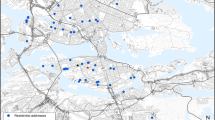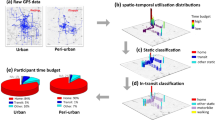Abstract
In the framework of the EXPOLIS study in Milan, Italy, 48-h carbon monoxide (CO) exposures of 50 office workers were monitored over a 1-year period. In this work, the exposures were assessed for different averaging times and were compared with simultaneous ambient fixed-site concentrations. The effect of gas cooking and smoking and different methods of commuting on the microenvironment and exposure levels of CO were investigated. During the sampling the subjects completed a time–microenvironment–activity diary differentiating 11 microenvironments and three exposure influencing activities: gas cooking, smoking and commuting. After sampling, all exposure and time allocation data were stored in a relational database that is used in data analyses. Ambient 48-h and maximum 8-h distributions were similar compared to the respective personal exposures. The maximum 1-h personal exposures were much higher than the maximum 8-h exposures. The maximum 1-h exposures were as well higher than the corresponding ambient distribution. These findings indicate that high short-term exposures were not reflected in ambient monitoring data nor by long-term exposures. When gas cooking or smoking was present, the indoor levels at “home-” and in “other indoor” microenvironments were higher than without their presence. Compared with ambient data, the latter source was the most affective to increase the indoor levels. Exposure during commuting was higher than in all other microenvironments; the highest daily exposure contribution was found during “car/taxi” driving. Most of the CO exposure is acquired in indoor microenvironments. For the indoor microenvironments, ambient CO was the weakest predictor for “home indoor” concentrations, where the subjects spent most of their time, and the strongest for “other indoor” concentrations, where the smallest fraction of the time was spent. Of the main indoor sources, gas cooking, on average, significantly raised the indoor exposure concentrations for 45 min and tobacco smoking for 30 min. The highest exposure levels were experienced in street commuting. Personal exposures were well predicted, but 1-h maximum personal exposures were poorly predicted, by respective ambient air quality data. By the use of time–activity diaries, ETS exposure at the workplaces were probably misclassified due to differences in awareness to tobacco smoke between smokers and nonsmokers.
This is a preview of subscription content, access via your institution
Access options
Subscribe to this journal
Receive 6 print issues and online access
$259.00 per year
only $43.17 per issue
Buy this article
- Purchase on Springer Link
- Instant access to full article PDF
Prices may be subject to local taxes which are calculated during checkout


Similar content being viewed by others
References
Akland G.G., Hartwell T.D., Johnson T.R., and Whitmore R.W. Measuring human exposure to carbon monoxide in Washington DC Denver Colorado during the winter of 1982–83. Environ Sci Technol 1985: 19: 911–918.
Alm S., Reponen K., Mukala K., Pasanen P., Tuomisto J., and Jantunen M.J. Personal exposures of pre-school children to carbon monoxide: roles of ambient air quality and gas stoves. Atm Environ 1994: 28: 3577–3580.
Alm S. Personal exposures of preschool children to carbon monoxide and nitrogen dioxide in urban air, Academic Dissertation. KTL, Kuopio Finland, 1999.
Alm S., Jantunen M.J., and Vartiainen M. Urban commuter exposure to particle matter and carbon monoxide inside an automobile. J Exposure Anal Environ Epidemiol 1999: 9 (3): 237–244.
Alm S., Mukala K., and Jantunen M.J. Personal carbon monoxide exposures of pre-school children in Helsinki, Finland: levels and determinants. Atm Environ 2000: 34: 277–285.
Brunekreef B., Smit H.A., Biersteker K., Boleij J.S.M., and Lebret E. Indoor carbon monoxide pollution in The Netherlands. Environ Int 1982: 8: 193–196.
Brunekreef B., Hoek G., and Janssen N. Time–activity patterns in air pollution epidemiology, In:Ackermann-Liebrich U., Viegi G., Nolan C. (Eds.). Time–activity Patterns in Exposure Assessment, Air Pollution Epidemiology Reports Series, Report no. 6, (EUR 15892 EN). European Commission Directorate General XII, Office for Official Publications, Luxembourg, 1995 92pp.
Burnett R.T., Dales R.E., Brooks J.R., Raizenne M.E., and Krewski D. Association between ambient carbon monoxide levels and hospitalisations for congestive heart failure in the elderly in 10 Canadian cities. Epidemiology 1997: 8: 162–167.
Clayton A., Perrit R.L., Pellizari E.D., Thomas K.W., Whitmore R.W., Wallace L.A., Ozkaynak H., and Spengler J.D. Particle total exposure assessment methodology (PTEAM) 1990 study: distributions of aerosol and elemental concentrations in personal, indoor, and outdoor air samples in a Southern California community. J Exposure Anal Environ Epidemiol 1993: 3: 227–250.
Cortese A.D., and Spengler J.D. Ability of fixed monitoring stations to represent personal carbon monoxide exposure. J Air Pollution Control Assoc 1976: 26: 1144–1150.
EPA. National Air Quality and Emissions and Trends Report, US Environmental Protection Agency, Research Triangle Park, EPA-454-95-005 1995.
Georgoulis L.B., Hänninen O., Samoli E., Katsouyanni K., Künzli N., Bruinen de Bruin Y., Alm S., and Jantunen M.J. Personal CO exposures in five European cities and its determinants. Atm Environ 2002: 36: 963–974.
Hänninen O. Langan.EXE — Databear download program Instruction sheet developed for use in the EXPOLIS study. Project software and document, KTL, Kuopio, Finland, 1996.
Hänninen O., Alm S., Kaarakainen E., and Jantunen M. The EXPOLIS Databases. Publications of the National Public Health Institute, B13/2002 KTL, Kuopio. ISBN: 951-740-321-6 (printed), ISBN: 951-740-322-4 (pdf-file), ISSN: 0359-3576, 408pp. 2002.
Jantunen M.J., Hänninen O., Katsouyanni K., Knöppel H., Künzli N., Lebret E., Maroni M., Saarela K., Sram R., and Zmirou D. Air pollution exposure in European cities: The “EXPOLIS” study. J Exposure Anal Environ Epidemiol 1998: 8: 495–518.
Jantunen M.J., Katsouyanni K., Knöppel H., Künzli N., Lebret E., Maroni M., Saarela K., Srám R., and Zmirou D. Final Report: Air Pollution Exposure in European Cities: the EXPOLIS Study. Publications of KTL B16/1999:127, pp. 4 Annexes, 1999.
Jungers R.H., Akland G.G., and Sauls H.B. A human exposure assessment study using personal monitoring of carbon monoxide. Direct and indirect methods. Environ Int 1985: 11: 413–418.
Klepeis N.E. An introduction to the indirect exposure assessment approach: modelling human exposure using microenvironmental measurements and the recent National Human Activity Pattern Survey. Environ Health Persp 1999: 107 (2): 365–374.
KTL. CO monitoring. EXPOLIS Standard Operation Procedure. KTL, Kuopio, Finland, 1997a.
KTL. CO monitoring and QA. EXPOLIS Standard Operation Procedure. KTL, Kuopio, Finland, 1997b.
Lee K., Yanagisawa Y., Spengler J.D., and Billick I.H. Measurement of personal carbon monoxide exposures by mailed passive samplers. J Air Waste Manage Assoc 1992: 42: 1212–1213.
Maroni M., Seifert B., and Lindvall T. Indoor Air Quality. A Comprehensive Reference Book. Elsevier Health Sciences, Amsterdam, 1995 ISBN: 0444816429.
Maroni M., Carrer P., Cavallo D., Alcini D., Basso A., Preti G., Vercelli F., Visigalli F., and Bersani M. Characterisation of personal exposure to air pollutants of subjects living in Milan. Proceedings of the 7th International Conference on Indoor Air Quality and Climate, Nagoya, Japan, 1996.
Moriske H.J., Drews M., Ebert G., Menk G., Scheller C., Schöndube M., and Konieczny L. Indoor air pollution by different heating systems: coal burning, open fireplace and central heating. Toxicol Lett 1996: 88: 349–354.
Naeher L.P., Leaderer B.P., and Smith K.R. Particulate matter carbon monoxide in highland Guatemala: indoor and outdoor levels from traditional and improved wood stoves and gas stoves. Indoor Air 2000: 10 (3): 200–205.
Nagda N.L., and Koontz M.D. Microenvironmental and total exposures to carbon monoxide for three population subgroups. J Air Pollution Control Assoc 1985: 35: 134–137.
Ott W.R., Thomas J., Mage D., and Wallace L. Validation of the simulation of human activity and pollutant exposure (SHAPE) model using paired days from the Denver, CO, carbon monoxide field study. Atm Environ 1988: 22 (10): 2101–2113.
Rotko T., Oglesby L., Künzli N., and Jantunen M.J. Population sampling in European air pollution exposure study, EXPOLIS: Comparisons between the cities representativity of the samples. J Exposure Anal Environ Epidemiol 2000: 10: 355–364.
Siegel M. Involuntary smoking in the restaurant workplace. J Air Waste Manage Assoc 1993: 270 (4): 490–494.
Thomas K.W., Pellizari E.D., Clayton A., Whitaker D.A., Shores R.C., Spengler J., Ozkaynak H., Froehlich S.E., and Wallace L.A. Particle total exposure assessment methodology (PTEAM) 1990 study: method performance and data quality for personal, indoor and out-door monitoring. J Exposure Anal Environ Epidemiol 1993: 3: 203–226.
Touloumi G., Samoli E., and Katsouyanni K. Daily mortality, and “winter type” air pollution in Athens, Greece — a time series analysis within the APHEA project. J Epidemiol Commun Health 1996: 50 (1): 47–51.
Vellopoulou A.V., and Ashmore M.R. Personal exposures to carbon monoxide in the city of Athens: commuters exposures. Environ Int 1998: 24: 713–720.
Wallace L., Thomas J., Mage D., and Ott W. Comparison of breath CO, CO exposure and Coburn model prediction in the US. EPA Washington–Denver (CO) study. Atm Environ 1988: 22: 2183–2193.
Wallace L.A. Recent field studies of personal and indoor exposures to environmental pollutants. Ann NY Acad of Sci 1992: 641: 7–16.
Wallace L. Real-time monitoring of particles, PAH, and CO in an occupied townhouse. Appl Occup Environ Hygiene 2000: 15 (1): 39–47.
WHO-a. Guidelines for Air Quality, WHO document. Geneva, WHO/SDE/OEH/00.02. 2000.
WHO-b. Air Quality Guidelines for Europe, 2nd edn. WHO Regional Publications, European Series, No.91. ISBN 92 890 1358 3.
Ziskind R.A., Fite K., and Mage D.T. Pilot field study: carbon monoxide exposure monitoring in the general population. Environ Int 1982: 8: 283–293.
Acknowledgements
This work has been supported by EC. Environment and Climate 1994–1998 Programme Contract N ENV4-CT96-0202 (DG 12-DTEE) and C.E. Ispra n. 18161-2001-07 F1ED ISP IT.
Author information
Authors and Affiliations
Rights and permissions
About this article
Cite this article
De Bruin, Y., Carrer, P., Jantunen, M. et al. Personal carbon monoxide exposure levels: contribution of local sources to exposures and microenvironment concentrations in Milan. J Expo Sci Environ Epidemiol 14, 312–322 (2004). https://doi.org/10.1038/sj.jea.7500327
Received:
Accepted:
Published:
Issue Date:
DOI: https://doi.org/10.1038/sj.jea.7500327
Keywords
This article is cited by
-
Personal carbon monoxide exposure, respiratory symptoms, and the potentially modifying roles of sex and HIV infection in rural Uganda: a cohort study
Environmental Health (2019)
-
Exposure Modeling of Benzene Exploiting Passive–Active Sampling Data
Environmental Modeling & Assessment (2010)
-
On exposure and response relationships for health effects associated with exposure to vehicular traffic
Journal of Exposure Science & Environmental Epidemiology (2008)
-
Simulation of working population exposures to carbon monoxide using EXPOLIS-Milan microenvironment concentration and time-activity data
Journal of Exposure Science & Environmental Epidemiology (2004)
-
The EXPOLIS study: implications for exposure research and environmental policy in Europe
Journal of Exposure Science & Environmental Epidemiology (2004)



